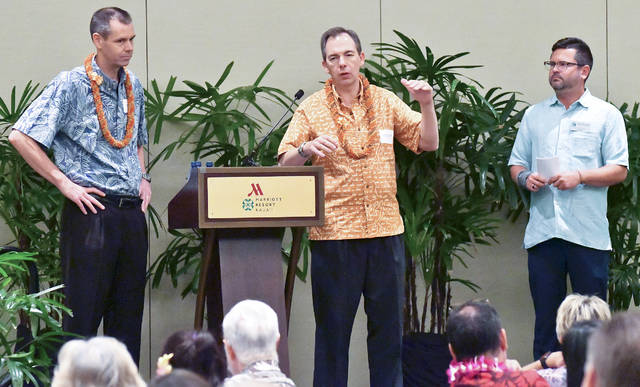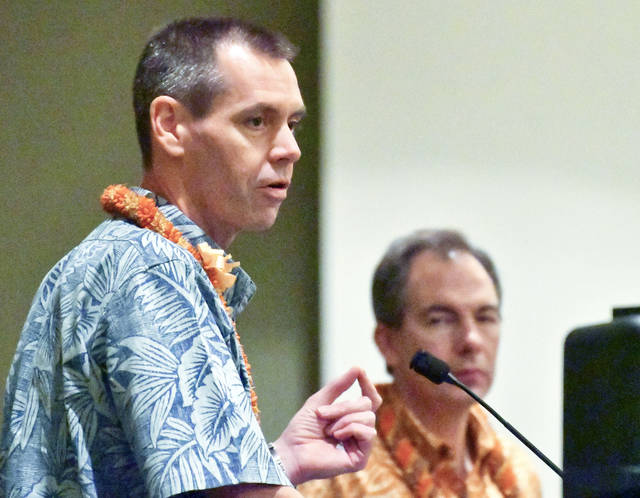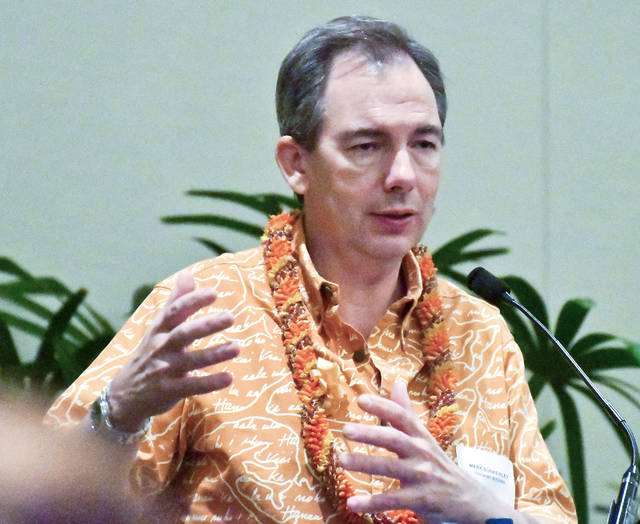LIHUE — In what was his final presentation on Kauai as the CEO and president of Hawaiian Airlines, a smiling Mark Dunkerley wanted to make one thing clear: “There’s no reason to travel on any other airline.”
While that comment drew laughs, Dunkerley meant it.
In a 30-minute talk before about 150 people at the Kauai Marriott Resort and Beach Club, Dunkerley cited the airline’s successes, challenges and, most of all, its commitment to the Hawaiian Islands. It’s adding flights, rolling out new planes and beefing up its nearly 7,000-member workforce, including hiring some of the 425 Island Air employees left in the cold when the airline suddenly closed last year, and purchasing some of Island Air’s assets.
“Who will be the beneficiary of that?” he asked the Kauai Chamber of Commerce crowd. “It’s going to be the Neighbor Islands.”
He made reference to competitors coming and going, while Hawaiian keeps standing strong and solid. While Dunkerley is stepping down March 1 after 15 years guiding the airline’s growth, he assured the Kauai audience the airline will stay connected with its customers here.
He said new services are being planned between Lihue and the Mainland, though he could not give specifics.
“What I can tell you, you will get them,” he said.
Dunkerley said retiring was an “extremely difficult decision,” but one that needed to be made for his family.
He is credited with leading the company’s turnaround. Under his leadership, Hawaiian Airlines successfully embarked on an Asia-Pacific growth strategy, as well as new routes to Auckland, New Zealand; Sydney and Brisbane, Australia; and New York City.
Since December 2002, Hawaiian has doubled the number of passengers flown annually, to 11 million. Over the same period the company’s gross revenues have increased four-fold, to $2.64 billion, and its employee count has doubled. Its share price has risen from a 52-week low of 29 cents in 2003 to a high of $60.90 over the last 52-week period.
In the third quarter of 2017, Hawaiian Airlines recorded net income of $74.6 million compared to $102.5 million for the same period last year, according to earnings released by the Honolulu-based company.
His successor will be Peter Ingram, current executive vice president and chief commercial officer. The two have worked together the past 12 years.
Ingram said the board is comfortable with the path Hawaiian Airlines is on, and that he would maintain its commitment to Kauai. There will be some changes, Ingram said, but not because he and Dunkerley disagree on the things, but because Hawaiian will continue to focus on growth and investing in its fleet and services.
“We have to continue to change and evolve this business,” he said.
Ingram said competition is fierce and expectations of passengers are high.
“It’s important for us to adapt,” he said.
Both men pointed to Hawaiian’s new Airbus A321neo aircraft that will soon begin flying between Hawaii and the West Coast as an example of how it will be meet demand.
The company’s new fleet of 18 single-aisle aircraft, referred to as a “new breed of technology,” will offer guests nonstop flights to more islands, starting with service to Kauai, Maui and the Kona Coast. The 189-passenger aircraft is ideal for the West Coast-to-Hawaii market, Dunkerley said.
Hawaiian’s inaugural A321neo flight is scheduled Monday on the carrier’s existing Kahului-Oakland route. New A321neo service between Kahului and Portland will launch on Jan. 18. Hawaiian’s seasonal summer wide-body service currently offered between Lihue and Oakland will resume April 11 as a daily A321neo flight.
While answering questions, Dunkerley said there will continue to be higher fares for peak times of the days, and less expensive fares for less-traveled times.
“We leave it to you to make the choice,” he said.
About then, Mark Perriello, Kauai Chamber president, added: “From what you just said, it sounds like we’ll all be taking the 6 a.m. flight,” he said, smiling, as the crowd laughed.
When asked about lower interisland fares, Ingram pointed out that since Island Air closed, there have been few, if any, claims that Hawaiian took advantage of the situation by increasing prices.
“That’s very much by design, because we haven’t,” he said.
Hawaiian, Ingram noted, is a for-profit enterprise and, to be successful, it must run a profitable business, so there is no plan to discount island fares.
Kamaaina coupons, Dunkerley said, won’t be coming back, referring to them as a “slippery slope.” He said the company wanted to avoid basing ticket prices on where you’re from, but rather on the kind of travel you do and how often you travel.
He said there were problems with the coupons, including that people booked high-demand flights months in advance of using them.
Both Dunkerley and Ingram said they don’t see the arrival of Southwest Airlines into the Hawaiian market as having a big impact on their operations. They noted Hawaiian already competes with major airlines daily and has honed its successful formula specific to this market.
“We’re not daunted by the challenge,” Ingram said.











The flight school is at Hikam Air Force base. They are on simulators for qualified pilots.
I suppose. But pilots and UH don’t mix. How’s the sale going? Getting richer? Island Airlines being bought off.
Avoid Hawaiian Airlines until they decide to buy American and not foreign aircraft
Name an airline that doesn’t have aircraft other than Boeing exclusively.
Yes, and avoid all Businesses that don’t use American Automobiles, and avoid all Businesses that use supplies from China, and, and, and…